An Interview with Ted Brandon
An N Scale Pioneer
By Max Magliaro
September 22, 2012
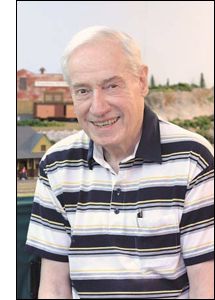 Ted Brandon is a very skilled and well-known model
railroader who has worked with multiple scales and railroading themes since the 1960s.
He has been a significant contributor to the advancement of N Scale. His RioVerde and Western Nn3 layout was ground-breaking and beautifully
constructed (see Kalmbach's Great Model Railroads 2001), and his most recent conversion of it to On30 continues in that tradition.
Ted Brandon is a very skilled and well-known model
railroader who has worked with multiple scales and railroading themes since the 1960s.
He has been a significant contributor to the advancement of N Scale. His RioVerde and Western Nn3 layout was ground-breaking and beautifully
constructed (see Kalmbach's Great Model Railroads 2001), and his most recent conversion of it to On30 continues in that tradition.
He is well known in the model railroad publishing world, having authored approximately 20 articles appearing in Narrow Gauge & Short Line Gazette, N Scale Railroading, Model Railroader, On30 Annual, and N Scale magazine. He is also the editor and major contributor to the books, Nn3 Manual: Modeling Narrow Gauge Railroads in N Scale, and Nn3 Handbook: For Modeling Narrow Gauge in N Scale. In fact, his early article in the February 1964 Model Railroader entitled, "000, the Smallest of the Small," introduced the United States to N Scale in many respects.
What many people may not realize is how instrumental Ted was in the creation of some of the early N Scale products, including steam locomotives introduced by Trix and Arnold in the 1960s, as well as his influence on the standardization of the Rapido coupler.
It is certainly true that Ted was responsible for helping to promote the scale in its infancy and in helping to get it "off the ground."
I had the great privilege of sitting down with Ted for a few hours to talk with him about his long and colorful life and his work with model railroading.
Ted's Early Life and Start with Model Trains
Ted was born in 1926 and grew up in Manhattan. He got started in the hobby much earlier than most of us, with a train set he received on his 3rd birthday, which he accidentally found hidden in the house before the big day.
Max Magliaro: When did you start playing with model trains? For me, it was around age 6.
Ted Brandon: Well, I've got you beat. I was 3! I got a train set for my birthday. The thing had been hidden under a couch someplace, and I had discovered it before my birthday. You can imagine how difficult it was for a 3-year-old to make believe that he hadn't seen his new toy! I think it was a Lionel. I don't recall exactly.
Ted quips that this little set caused him to experiment with the first model point-to-point layout, because it was missing one curved section of the oval! This early set did not lead to much more in the way of model trains during Ted's youth. He started experimenting with models as a teen, but that was quickly cut short by his service in World War II.
Teenage Years, War Service, Working for the Railroad
MM: As you grew up, were you building other layouts at home?
TB: No. No. I would play with the train, and that was pretty much it for quite a while. I didn't really get into it until I got into my teens.
MM: I see. When you reached your teens, what did you start doing?
TB: Well, this was right around the time the war started, in 1941. That would have made me 15. I had a Marx or Bing locomotive I had gotten my hands on. I decided to make a better-looking steam locomotive. I built something out of cardboard, including a cardboard roll from toilet paper. That was the boiler.
Meanwhile, at the age of 16, Ted lived away from his New York City home, taking a summer job working for the the Jersey Central Railroad as an apprentice mechanic in the Jersey City roundhouse. The following summer he took a similar job for the Lehigh Valley Railroad.
TB: I lived on my own over there. There was no such thing as commuting. I couldn't have afforded it. I rented a little room somewhere. We put in a lot of hours. There was a lot of pressure to keep the railroads running during WWII. We often worked 12-hour shifts.
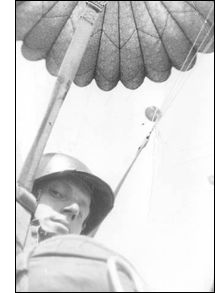 Soon after that, he volunteered to serve in WWII,
enlisting in the U.S. Army at age 17. He was underage, so he needed his widowed mother's
permission.
Soon after that, he volunteered to serve in WWII,
enlisting in the U.S. Army at age 17. He was underage, so he needed his widowed mother's
permission.
TB: I was only 17, but I was able to persuade my mother that I should go and do my duty.
MM: What branch of the army were you in?
TB: I was a paratrooper in the infantry.
At right: Private Ted Brandon (US Army, 1943) took this photo of himself while descending. It is his first jump. The Brownie camera was destroyed on landing, but the film survived.
Some people may know that Ted was stationed in Germany and started his work with the Trix and Arnold Rapido companies while he was there. But that all came much later.
TB: I went through the war in the Pacific, ended up in the occupation of Japan, and got back [to the United States] in 1946.
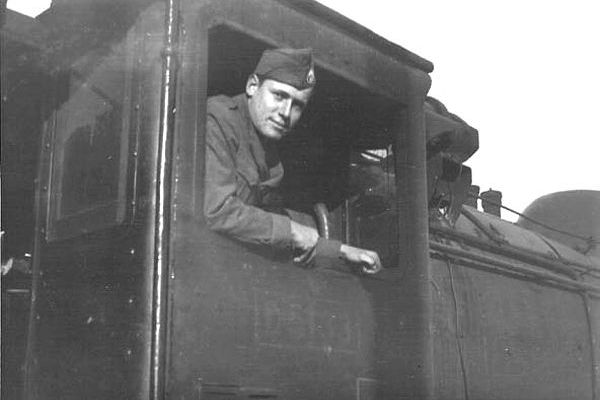
Above: Sgt Ted Brandon, US Army, Late 1945, Yamagata, Japan, at the throttle of 1-meter gauge Mikado #D5133.
Ted was the acting "S2" (intelligence officer). He would travel to different towns in his stationed area to conduct inspections. He made friends with the Japanese engine crews, and they would sometimes let him run the locomotive.
Ted attended Temple University in Philadelphia for 2 years, and worked for the Reading Railroad as a brakeman in 1947 and 1948.
TB: Again, it was very hard work. I lost more lives on that job with the railroad than I did during the war. In Philadelphia, there was a yard at Erie Ave, and there was a bridge across the yard tracks. I was on top of a boxcar. There was a lot of steam from the locomotive in front of me, in the direction of travel. The next thing I knew, I got hit over the head with a bridge, because I hadn't seen it. They didn't have any "tell-tales." Another time, again, I was on top of a car, and somebody yelled at me suddenly, Look Out! All of a sudden, coming right at me at belly level, came the 1100-volt overhead wire for the Erie Avenue trolleys. I was fortunate. I was able to fall backwards before it hit me.
Off to Germany, Marriage, and a Return to the Hobby
MM: So, you worked for some railroads as a teenager, went to war, came home and worked for the Reading Railroad and went to school at Temple. How is it that you ended up in Germany?
TB: Well, I realized that I wasn't going anywhere, so I decided to go back into the service. I had been on continuous duty in the Reserves after the war, so I had rank and I re-enlisted. I ended up in Fort Campbell, KY with a paratrooper regiment in 1951. I eventually received a commission as a second lieutenant after graduating from Officer Candidate School. From there, I was shipped overseas, and ended up in Berlin, Germany. I met my wife there, by the way.
MM: I noticed her first name, and I wondered if you met her in Germany. (Ted's wife's name is Inge.)
TB: Yes, she's from Berlin. I had a great time there. This was in 1952. I was there for two years, came back to the United States. I invited my "wife to be" (although she didn't know it yet!) to visit the United States. The first time, the U.S. Government wouldn't allow it, because they suspected she would try to get married over here. But the second time, they let her come, and we did get married.
MM: Did she speak any English at the time? How did that work out?
TB: Oh, I'm fluent in German. I had studied it in High School. And Inge spoke English quite well.
TB: After we got married, I got shipped off to Korea, luckily after the armistice was signed so there was very little fighting at that time. I was there for 13 months. When I came back, we were here in the U.S. for a couple of years.
MM: Were you tinkering with model trains again at this time?
TB: I was reading about model trains in the press, but I didn't have a chance to build anything because we had been moving around too much. Then, in 1963, I got further orders to go to Germany. Just before we left the United States to go to Germany, I read about these little trains that were coming out by a company called Rapido. There was this outfit on Fifth Ave in Manhattan, the offices of Charles Merzbach and Company. They were distributing Rapido trains in the United States. So I decided to go over there to take a look at them. This fellow Merzbach showed me what he had, which was Arnold. I got very interested. So when we got over to Germany, I decided that what I had seen in the way of products for the American market hadn't really impressed me with their prototypical accuracy. I thought there was a lot of room for growth in this scale.
MM: Now, why did you think that? At the time, N Scale was really still a novelty. A lot of people thought it would never amount to much. So what about it made you think it had a future?
TB: Well, I knew a lot of people were pressed for space for a layout, and this offered an opportunity that was beyond anything that was possible at the time. And it was charming in its way, and I thought it would grow as a scale.
Germany, and Initial Work with Arnold — 1963
TB: So after I got settled in Germany, I decided to contact Arnold. I wrote to them and said I thought there were possibilities for marketing U.S. equipment, and I asked them if they were interested.
MM: I'd like to know more about this. Did you just look up an address and send them a letter, "cold?"
TB: Yes.
MM: So you wrote them a letter, and what happened?
TB: Well, they wrote back, and they said they would like to discuss it and they asked me if I would come down to Nürnberg to talk to them about it.
MM: Just like that? You sent them a letter, and they invited you to their plant and wanted to talk to you? That's amazing. I imagine that if I wrote a letter like that to a manufacturer today, I doubt they would invite me to their plant to talk to their engineers or company leaders.
TB: Well, the situation was different at the time. This was an evolving scale. There were lots of directions it could go in. The company had a 100-year history as a toy-maker. So it wasn't as if they were "Johnny-Come-Lately." In fact, they were family-owned, and had an excellent reputation in the toy field.
MM: They were a big company at the time, even though they were just getting started with N Scale trains. When you went to visit them, was it in a large facility?
TB: I went to their main headquarters, which was a rather huge building, in Nürnberg. They made some N Scale stuff at that location, and they had some other factories elsewhere. Nürnberg was the center of all the toy-making in Germany at the time. They sent me a first-class railroad ticket, and I went to see them. They were very formal in business. There is no such thing as "Hi Ted, nice to meet you." It was all very formal. A lot of them had titles, such as Doctor in the fields of business, philosophy, or science. So I was "Herr Major," and they were "Herr Doktor." They had a beautiful board room with heavy oak paneled walls, a big conference table and big comfortable chairs. There were display cases all around the room showing toys they were producing or planning to produce.
MM: Did you bring anything to this first meeting like drawings or photographs of some of your ideas?
TB: No. That came later. On that first trip, we just got acquainted. They asked me what I thought would be of interest in the United States if they went into the U.S. market. They were making a big investment, so it was important to get it right.
The Arnold Rapido 4-6-2 Pacific — 1963-1967
TB: I went home, and then we had another meeting later. I don't have dates for when these meetings were, but it was not long after, sometime in 1963. The next time I went, they asked me to be more specific, asking me what particular models I would start out with. I had given this some thought. I suggested a Pacific (4-6-2) steam locomotive because Pacifics were used in passenger, mixed, and freight service, so they had broad appeal. I thought a lot about what particular engine it might be. My favorite among the Pacifics was the Southern PS-4.
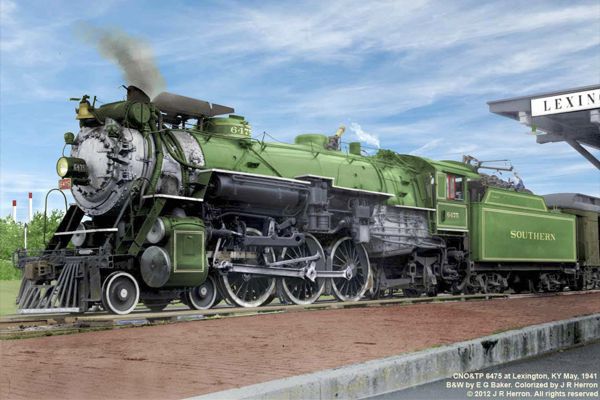
Above: Classic rendering of a Southern Railway PS-4 4-6-2 Pacific (Photo by E.G. Baker, colorized by J.R. Herron, used by permission of J.R. Herron).
TB: But I felt, no, that was too specific, too limited. What we really wanted was a machine that was in use throughout the U.S. and was well-known everywhere, so I chose the USRA Pacific. Then, we had to choose between the light and the heavy version. I opted for the heavy. I picked the heavy, in part, because it would leave more room for the motor.

Above: A USRA 4-6-2 Heavy Pacific as-built for the Erie Railroad. Alco historic photo.
MM: Were you thinking about that aspect of it when you were choosing what engine to build?
TB: Oh yes. I don't know if motor size would have been a problem, but I simply decided at the time that it would be better to be safe than sorry. The discussions with them were quite intense. They were wondering if they would have to start from scratch, or if they could reuse some elements they already had. They had come out with a German version of a Pacific, the series 01, one of the most famous German steam locomotives. I saw preproduction models of that, and I had a chance to look at some parts they had made. I said that the best way to go would be to base the American engine on the 01 series chassis. It had huge drivers, at least 72", probably 74". The cylinder size was close. Everything just seemed to fit, so that's what they decided to do.
MM: So this all developed from a series of conversations between you and the Arnold executives, and they decided to build their first American prototype model based on those talks. Did they try to confirm what they heard from you with anyone else, or did they pretty much believe your opinions about what would do well in the American market?
TB: Well, they couldn't just take my word for it. I wasn't really qualified as an expert about the market in the United States. I had ideas, but I was not an expert. I'm sure they did some research. They certainly must have talked to Charles Merzbach in Manhattan, since he was the distributor at the time. At one of these meetings, I brought with me a copy of the Steam Locomotive Cyclopedia [Model Railroader Cyclopedia, Volume 1: Steam Locomotives, edited by Lynn Westcott, Kalmbach Publishing] to show them plans, so they could copy them. As you know, in those days, there was no internet.
MM: So they started their design with the drawings in that Cyclopedia book?
TB: Yes. I had a late edition of that book at the time, which was printed in 1960. So that took care of the Arnold Pacific. They finally came out with it, and it was very popular.
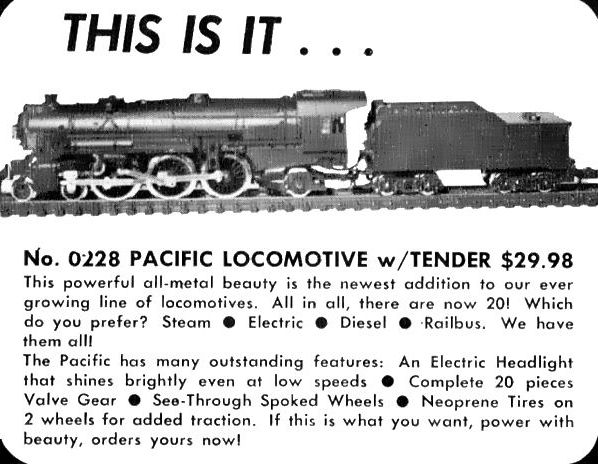
Above: An early ad for the Arnold-Rapido 4-6-2 Heavy Pacific in N Scale, which went into commercial production in 1967.
MM: Did they give you any preproduction samples to get your feedback on it as they developed it?
TB: No. I made fairly regular visits to Nürnberg to visit them and to visit Trix, later on. So I saw how they were coming along with it. The Arnold Pacific was very heavy. It was all cast metal. It ran very well.
MM: I would think that at the time, it would be hard to make a motor that small. Motor technology wasn't up to where it is now.
TB: How right you are. On this one, Arnold had developed a 3-pole motor that was surprisingly strong, durable, had good slow-speed starting characteristics, and just in general, considering the state of the art at the time, it was very well done. It was relatively large. That's something we had to consider when choosing the Pacific.
MM: The tender pickup system in the Pacific has pickup on both sides, without wipers.
TB: Yes, but it only has pickup on 4 wheels. It would have been too difficult at the time to insulate the halves on each axle.
MM: A couple of years later, they introduced a Hudson based on the same engine.
TB: That's right. Somebody at Arnold decided to stick an extra axle under the firebox, but I can't say I care for it. That happened long after my time.
MM: Do you know anything about the large flanges that Arnold tends to use on their engines? Is that something they did as a design decision?
TB: Yes, they were oversized for better tracking. That was a result of being "first" in so many respects. It was all so small and so touchy, they never thought in terms of "RP-25." Their later models were much better in this regard.
Ted's Work on the Rapido Coupler
TB: After I had done my work there at Arnold, then came the question of the coupler. Up to that time, I had been dealing with the Arnold CEO, Max Ernst, and a few assistants from the engineering department. They had come out with a coupler after they realized that the tinplate hook-and-loop style things they had on their early toys weren't going to do. At that time, each manufacturer had its own coupler, and none of them worked together. So Arnold developed a new coupler that would couple on the tracks (without lifting cars off the track), it locked solid, you could push a train (not just pull it), and there was a little pin sticking down that could be used with an uncoupling ramp track, which they made. One day, during the development of the 4-6-2, with almost the entire board present at the meeting, I took the opportunity to say that I felt the greatest thing they could possibly do to assure their own success in the United States and anywhere would be to license their new coupler to all manufacturers.
MM: Where they receptive to the idea at first, or did you have to talk them into it?
TB: Oh no. I was not in a position to talk them into anything. There was some discussion and I'm sure there was more after I left, and they did decide to do it. As a result, the Arnold coupler became a world-wide standard, and continued to be a standard even well after the Micro-Trains coupler came out.
In addition, Ted informs me that Arnold asked him to translate instruction sheets and some of their first catalogs from German to English.
Trix and the K4
The Trix company introduced the 4-6-2 Pacific, based on the Pennsylvania Railroad K4 prototype, in the late 1960s. It was so successful that the company continued selling them, with minimal changes, up until 1999.
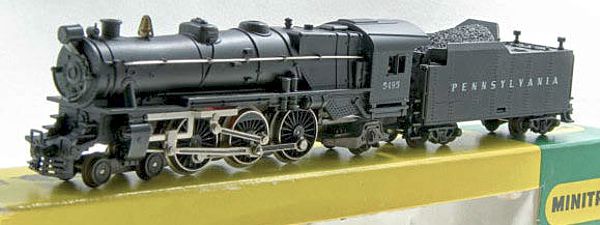
Above: The Trix K4 4-6-2 Pacific (Trix created the name Minitrix for their N Scale line).
MM: I'd like to now turn to how you started talking to Trix about the K4.
TB: As I recall, I met the Trix people (not "Minitrix," the company was called "Trix") at the 1964 Nürnberg Toy Fair. If you want to go to a big commercial exhibition, you've got to go to this toy fair. They had something like 1000 exhibitors. I went to their stand and here was this cute-as-a-button little train consisting of an 0-6-0 tank engine and two German prototype 2-axle passenger cars. The locomotive was modeled on the German T3. The T3 was somehow etched in German history and the affection of modelers, a cute little machine with a side tank and a tall stack.
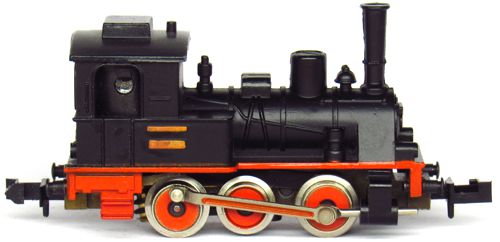
Above: The early Trix T3 model.
Arnold had tried to model a T3, but it was oversized, the proportions were wrong, and you would not really recognize it for a T3. This little thing from Trix was a single casting with a standing motor over the back of the rear axle. There was only a main rod (no side rods) and the drivers were only flat discs. I must have said, "You really ought to think about doing something in the American market." They said, "We're already getting into it." I got an invitation to visit, and they wanted to hear my thoughts. We essentially went through the same drill I had gone through with Arnold.
MM: So basically, you are talking to the Trix people at this big train fair, and they invite you to come and talk to them some more about potential American models?
TB: Yes, essentially, that's what happened.
MM: Again, I am impressed by that. I know things are different now, but I can't imagine talking my way into a meeting like that just by talking to these guys at trade shows.
TB: Yes, well, these people were embarking on something new. This Minitrix was all new, and they were thinking forward. And it was a time when Germany was going through a tremendous commercial expansion. They call that period (I'll try to translate it) "The Wonder Years," or "The Economic Miracle Years." They were doing very well. You have to remember, the war hadn't been over all that long. In a manner of speaking, I was still the "enemy."
MM: I take it they had no animosity toward you because you were an American. They seem not to have minded that at all.
TB: No. In fact, Americans were very popular at the time. When I was in Berlin in the early 50s, I could walk anywhere in Berlin, and never gave it any thought. When I drove my MG through Berlin, the car was known to every policeman in the city, and they would stop traffic and let me through. That's how well-liked Americans were in Germany. So anyway, I visited the Trix people, and spoke with their chief engineer. The first question was, "What should we build?" I found myself in sort of a bind, because I was working with Arnold at the same time, here I was working with their direct competitor. I should mention that it was clearly understood by all parties that I would not ever tell one of them what the other was doing or planning.
MM: So both Arnold and Trix knew that you were consulting for both companies?
TB: Well, the subject never came up. Arnold never said, "You be sure never to tell Trix what we're doing." Nothing like that. There was just no question about it. They both knew.
TB: So when the subject of locomotives came up, I saw that Trix was working on their version of the German 01 series Pacific. It was very nicely done. There were two different engineering approaches back then. Arnold was a bit heavy-handed in their design. Trix was more graceful. They were the first ones to make drivers with individual spokes.
MM: Yes, you can see through them on the K4.
TB: Yes, that makes all the difference, I think. So, anyway, I went to my Cyclopedia again. I wanted to give them a locomotive that would be very popular. I knew the Pennsy was very popular in all parts of the [eastern] United States, even other parts outside this end. And given the chassis they were working on, it was a natural.
MM: That's a point I wanted to ask you about. You yourself were not especially a PRR modeler. You just thought that the K4 would be very popular.
TB: No. I've never been a PRR "fan" as such. I think it was a fabulous railroad. They built their own locomotives. I mean, who else does that? But no, I was not a particular Pennsy fan. I just thought that this would have appeal. Now, after I left Germany, at least after I had no more connection with the Trix people, somebody decided, "Well, we have a K4 Pacific. Why can't we have an I-class Pennsy Decapod and use the same boiler?" Of course, they didn't do it right. The two boilers are about the same length, but the way they mounted it with the stack not lining up with the cylinders, it was terrible!
MM: As they started to produce the tooling and the test pieces for the K4, did they ever show you any of that, or were you pretty much out of it by that time.
TB: I don't recall going through that like I did at Arnold. At Arnold, I did see some progress as it went along. At Minitrix, I mostly just recommended what to build, and gave them the Cyclopedia drawings.
MM: It's interesting that they didn't know about the existence of that book.
TB: Well, in those days, there wasn't that much of a connection between manufacturers, especially between Europe and the United States. That didn't develop until later. The Germans were more oriented toward Great Britain, for example. Trix made a number of models of British prototypes. Their products didn't become popular here until much later. I don't remember exactly when the K4 actually went into production. I thought it was somehow more graceful. The Trix motor was completely different. At the time, they only had one motor, and they used it in different engines, some single and some double shaft. It was smaller, but not as hearty as the Arnold motor. The windings were very fine. The commutator pieces were very small and had a tendency to come off.
MM: Well, that pretty much wraps up the story of the K4. Tell me, did you have anything to do with the Trix B6 that came later?
TB: No. I had nothing to do with the B6 at all, but I think they did a pretty good job.
MM: I wonder if they went down the PRR path (with the B6) because the K4 had been so successful.
TB: It would make sense for them to go with something they had success with. It was logical to make another PRR engine. I think the B6 had to have been designed after the K4. I never saw anything being done on the B6. If they had shown me that while I was there, I would have said, "Well, you're already doing a Pennsy engine, so for a switching locomotive, you may as well do Pennsy." But anyway, that never happened.
Wrap-Up
MM: In general, when you were talking to these companies, and working with them, were you aware that what you were doing was somehow significant? Did you have the feeling that you were lucky to get to talk to them?
TB: I suppose. I was making a contribution to the hobby, and something was going to happen as a result. They were very forthcoming, and very friendly.
MM: And of course, you could speak German, so you had a big advantage there. Or did they speak English? How did you communicate?
TB: Oh, we did it all in German. I had to learn. While I was at it, there were expressions I had never heard before, but that didn't take long.
While we were wrapping up our meeting, Ted mentioned the following, which I have to confess, would make any loco kitbasher jealous! But in all fairness, Ted certainly earned the right to what he mentions below, much more than most of us!
TB: I remember using those little brass sleeves from the K4 axles. I should mention that during the time I was working with the two companies, I had access to all the parts I wanted, really. I could have gone with my hand into the different parts drawers and just helped myself. They gave me whatever I asked for and gave me whatever I needed. I used those little brass sleeves on a number of N Scale locomotives I built from scratch.
MM: Your N Scale layouts and narrow-gauge work are quite famous. I'm sure you know that!
TB: Well, I appreciate that. I enjoy sharing things. That's partly what the hobby is about, isn't it?
With appreciation and thanks to Max Magliaro for permission to reproduce this interview; to N-Trak, who originally published this interview in their N Scale Steam Locomotive Information Book 2012 Addendum; and most especially to Ted Brandon for his tremendous contributions to the growth of N Scale.
